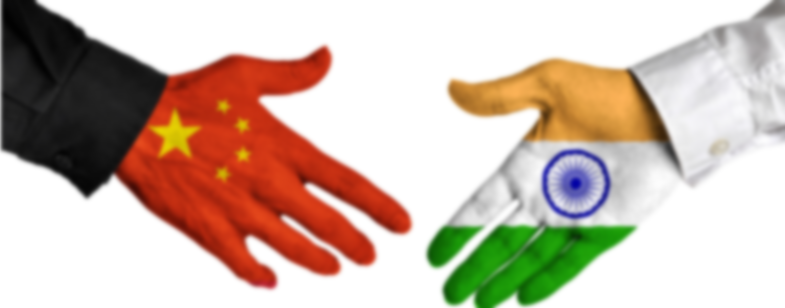By: Brigadier Anil John Alfred Pereira, SM (Retd)

” There is no friendship without self-interests. This is a bitter truth.” – Chanakya
History is replete with examples of sworn adversaries transforming into strategic allies when their interests align. France and Germany, which fought two World Wars, are today the anchor of the European Union as partners in peace and progress. The United States and Vietnam, once bitter enemies, now cooperate on trade and regional security. Japan and South Korea, despite a painful history, work together in technology and regional security. To see the Dragon and Elephant tango together may seem improbable today but could very well become tomorrow’s strategic necessity when the future takes precedence over the past.
The Past
India and China, with our millennia-old civilisational legacies and modern geopolitical heft, are natural candidates for a transformation from adversaries to friends as qualified by the phrase “Hindi-Chini Bhai Bhai“, coined in the early 1950s. Bound together by land and history, we share ancient philosophies, vibrant traditions, and parallel struggles. While time and tensions have dimmed that spirit, the possibilities for renewed cooperation remain vast in today’s complex, multipolar world.
Both India and China are proud inheritors of great river valley civilisations that gave rise to profound systems of thought, spirituality, governance, and innovation. From ancient scriptures, universities, medicines to intricate arts and crafts, both nations shaped global culture and knowledge. For centuries, we were among the world’s largest economies, trading silk, spices, ideas, and inventions across Asia and beyond. The colonial and imperial periods, however, changed this trajectory. Both nations suffered foreign domination, internal turmoil, and economic decline. Poverty, hunger, and disempowerment gripped our populations for decades until in late 20th century when both India and China began charting a new course towards development and global relevance.
The Present
Today, our countries stand as resurgent powers. China, with its manufacturing prowess and infrastructure boom, and India, with its demographic dividend, vibrant democracy, and technological growth, are reshaping the global economic and political landscape. We are among the world’s largest producers of grains, minerals, steel, electronics, pharmaceuticals, and digital services. Both countries are now assertive participants in global trade, commerce and innovation. Despite distinct languages and traditions, we share deep-rooted cultural similarities that reflect our parallel civilisational evolution. Our societies place a strong emphasis on family values, respect for elders, collective harmony, and the pursuit of knowledge and advocate moral conduct, self-discipline, and societal duty. Festivals in both nations celebrate nature, harvest, and spiritual renewal. The shared legacy of Buddhism, which originated in India and took deep root in China, is perhaps the most profound cultural bridge, visible in art, sculpture, philosophy, and monastic traditions across both countries. These enduring commonalities remind us that cultural understanding between the two nations is not a new aspiration, but a rediscovery of long-standing ties.
Convergence of Interests
Despite geopolitical frictions, we both share many overlapping interests. We seek economic growth, energy security, food sufficiency, and technological advancement for our massive populations. Our positions in multilateral platforms like BRICS, SCO, and G20 often align on reforming global institutions to better represent developing nations. We have invested heavily in renewable energy, green technologies, artificial intelligence, and digital public infrastructure. Issues like climate change, pandemic preparedness and fair-trade offer ample ground for practical collaboration. A stable and peaceful neighbourhood is in the interest of both countries. Avoiding conflict along the Line of Actual Control (LAC) and pursuing confidence-building measures can free up resources and finances for developmental goals. People-to-people exchanges, cultural collaborations, and academic linkages can help foster mutual understanding beyond political narratives.
Divergence of Interests
At the same time, the divergences between our countries are real and persistent. The unresolved boundary dispute remains a flashpoint, as seen in recent standoffs. China’s close strategic and economic ties with Pakistan, including infrastructure projects in disputed territories and until recently the weapon and material aid with intelligence support provided during Operation Sindoor are not acceptable to us. China’s forays into the immediate neighbourhood i.e. Bangladesh, Nepal, Myanmar, Sri Lanka and Indian Ocean Region are viewed with suspicion in India. Similarly, India’s growing alignment with the United States, Japan, and Australia through groupings like the Quad is often perceived by China as a counterbalance. There are also tensions over trade deficits, market access restrictions, and differing worldviews India being a democracy and China a one-party state. Additionally, regional influence in South Asia and the Indo-Pacific is a subtle but significant arena of competition. Nationalist sentiments on both sides often aggravate these fault lines, making dialogue challenging, even when mutual benefit is apparent.
The Future
In today’s shifting global landscape, where unipolar dominance is giving way to a multipolar world order, India and China have a historic opportunity to lead by cooperation instead of being rivals locked in distrust and suspicion. We can serve as co-creators of a more balanced, equitable rules based global order built on pillars of stability, cooperation, and balanced development. Our combined voice can amplify the concerns of the Global South, push for sustainable development, and resist coercive economic models. Peaceful resolution of border issues and mutual respect for sovereignty can unlock immense potential in trade, innovation, and cultural exchange.
History teaches that civilisations rise and fall not just through war, but through their capacity to adapt, collaborate, and learn from each other. If India and China can navigate their differences with maturity, and build on their civilisational wisdom and shared aspirations, we can become beacons of peace, stability, and prosperity in Asia and the world. India and China are well-placed to demonstrate that even powerful neighbours with differences can rise together, neither at the cost of the other, nor at the mercy of external powers. The road ahead may be long and uneven, but the journey is worth taking. The promise of renewed Hindi-Chini Bhai Bhai relations can become the beacon of hope the world needs in these turbulent times. In its success lies the promise of an Asia that rises together, united in its diversity and destiny.

About the Author
Brigadier Anil John Alfred Pereira, SM (Retd) is a Veteran from Goa, who served the nation with distinction for 32 years.

